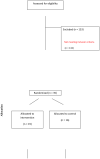Commercially available lifestyle modification program: randomized controlled trial addressing heart and bone health in BRCA1/2+ breast cancer survivors after risk-reducing salpingo-oophorectomy
- PMID: 27873046
- PMCID: PMC5386323
- DOI: 10.1007/s11764-016-0582-z
Commercially available lifestyle modification program: randomized controlled trial addressing heart and bone health in BRCA1/2+ breast cancer survivors after risk-reducing salpingo-oophorectomy
Abstract
Purpose: The goal of this RCT was to examine the efficacy and safety of a web-based program to improve cardiovascular and bone health outcomes, among 35 BRCA1/2+ breast cancer survivors who underwent prophylactic oophorectomy and thus experienced premature surgical menopause.
Methods: A 12-month commercially available web-based lifestyle modification program (Precision Nutrition Coaching) was utilized. Cardiovascular fitness, dietary intake, leisure time activity, body composition, bone mineral density, bone structure, and muscle strength were assessed.
Results: Average adherence to all program components was 74.8 %. Women in the intervention group maintained their cardiovascular fitness level over the 12 months (1.1 ± 7.9 %), while the control group significantly decreased fitness capacity (-4.0 ± 7.5 %). There was a significant difference between groups in percent change of whole body bone area (-0.8 ± 2.5 control and 0.5 ± 1.30 intervention). We also observed decreased BMI (-4.7 ± 6.2 %) and fat mass (-8.6 ± 12.7 %) in the intervention group due to significant concomitant decreases in caloric intake and increases in caloric expenditure. The control group demonstrated decreased caloric intake and decreased lean tissue mass.
Conclusions: In this population at high risk for detrimental cardiovascular and bone outcomes, a commercially available lifestyle intervention program mitigated a decline in cardiovascular health, improved bone health, and decreased weight through fat loss.
Implications for cancer survivors: Precision Nutrition Coaching has shown benefit in breast cancer survivors for reduced risk of deleterious cardiovascular and bone outcomes.
Keywords: BRCA1/2; Bone; Exercise; Heart; Neoplasm; Weight loss.
Figures



Similar articles
-
Change in Inflammatory Biomarkers and Adipose Tissue in BRCA1/2+ Breast Cancer Survivors Following a Yearlong Lifestyle Modification Program.Cancer Prev Res (Phila). 2018 Sep;11(9):545-550. doi: 10.1158/1940-6207.CAPR-18-0098. Epub 2018 Jun 20. Cancer Prev Res (Phila). 2018. PMID: 29925515 Clinical Trial.
-
Effects of lifestyle intervention in BRCA1/2 mutation carriers on nutrition, BMI, and physical fitness (LIBRE study): study protocol for a randomized controlled trial.Trials. 2016 Jul 29;17:368. doi: 10.1186/s13063-016-1504-0. Trials. 2016. PMID: 27473440 Free PMC article. Clinical Trial.
-
A cognitive behavioral therapy intervention to promote weight loss improves body composition and blood lipid profiles among overweight breast cancer survivors.Breast Cancer Res Treat. 2007 Aug;104(2):145-52. doi: 10.1007/s10549-006-9410-x. Epub 2006 Oct 21. Breast Cancer Res Treat. 2007. PMID: 17058023 Clinical Trial.
-
Prophylactic oophorectomy in women at increased cancer risk.Curr Opin Obstet Gynecol. 2007 Feb;19(1):27-30. doi: 10.1097/GCO.0b013e32801195da. Curr Opin Obstet Gynecol. 2007. PMID: 17218848 Review.
-
Cardiovascular risk of BRCA1/2 mutation carriers: A review.Maturitas. 2016 Sep;91:135-9. doi: 10.1016/j.maturitas.2016.06.012. Epub 2016 Jun 22. Maturitas. 2016. PMID: 27451331 Review.
Cited by
-
The Yale Fitness Intervention Trial in female cancer survivors: Cardiovascular and physiological outcomes.Heart Lung. 2017 Sep-Oct;46(5):375-381. doi: 10.1016/j.hrtlng.2017.06.001. Epub 2017 Aug 10. Heart Lung. 2017. PMID: 28803675 Free PMC article. Clinical Trial.
-
Digital Health Interventions for Adult Patients With Cancer Evaluated in Randomized Controlled Trials: Scoping Review.J Med Internet Res. 2023 Jan 6;25:e38333. doi: 10.2196/38333. J Med Internet Res. 2023. PMID: 36607712 Free PMC article.
-
Interventions for promoting habitual exercise in people living with and beyond cancer.Cochrane Database Syst Rev. 2018 Sep 19;9(9):CD010192. doi: 10.1002/14651858.CD010192.pub3. Cochrane Database Syst Rev. 2018. PMID: 30229557 Free PMC article.
-
The impact of arm lymphedema on healthcare utilization during long-term breast cancer survivorship: a population-based cohort study.J Cancer Surviv. 2020 Jun;14(3):347-355. doi: 10.1007/s11764-019-00851-0. Epub 2020 Mar 14. J Cancer Surviv. 2020. PMID: 32172321 Free PMC article.
-
Lifestyle interventions with dietary strategies after breast cancer diagnosis: a systematic review.Breast Cancer Res Treat. 2024 Jul;206(1):1-18. doi: 10.1007/s10549-024-07278-x. Epub 2024 Mar 29. Breast Cancer Res Treat. 2024. PMID: 38551752
References
-
- Jones LW, Haykowsky MJ, Swartz JJ, Douglas PS, Mackey JR. Early breast cancer therapy and cardiovascular injury. J Am Coll Cardiol. 2007;50(15):1435–41. doi:S0735-1097(07)02240-1 [pii] - PubMed
-
- Campeau PM, Foulkes WD, Tischkowitz MD. Hereditary breast cancer: new genetic developments, new therapeutic avenues. Hum Genet. 2008;124(1):31–42. doi:10.1007/s00439-008-0529-1. - PubMed
-
- Pal T, Permuth-Wey J, Betts JA, Krischer JP, Fiorica J, Arango H, et al. BRCA1 and BRCA2 mutations account for a large proportion of ovarian carcinoma cases. Cancer. 2005;104(12):2807–16. doi:10.1002/cncr.21536. - PubMed
Publication types
MeSH terms
Substances
Grants and funding
LinkOut - more resources
Full Text Sources
Other Literature Sources
Medical
Miscellaneous

